 W
WCardiff Horse Show, also the Cardiff and South Wales Horse Show or Royal Horse Show was an annual horse show in May in Cardiff, south Wales in the late 19th and early 20th centuries. It attracted farmers from all across Glamorganshire. It was held at Sophia Gardens.
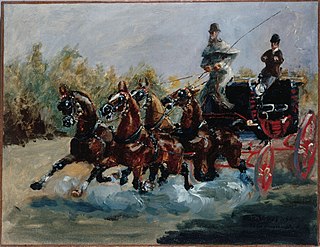 W
WCarriage driving is a form of competitive horse driving in harness in which larger two or four wheeled carriages are pulled by a single horse, a pair, tandem or a four-in-hand team. Prince Philip helped to expand the sport. He started to compete in carriage driving in 1971, and the early rule book was drafted under his supervision.
 W
WA cob is traditionally a draft type pony. Should be of a stout build, with strong bones, large joints, and steady disposition; it is a body type of horse rather than a specific breed. Historically, in the United Kingdom and, to a lesser extent, the eastern United States, a 'cob' may be a common horse used for everyday riding but in the past was used for driving carts.
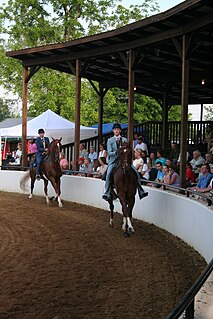 W
W"English pleasure" is the generic term for a number of different English riding classes seen at horse shows in the United States, where the horse is ridden in either hunt seat or saddle seat tack.
 W
WEnglish riding is a form of horse riding seen throughout the world. There are many variations, but all feature a flat English saddle without the deep seat, high cantle or saddle horn seen on a Western saddle nor the knee pads seen on an Australian Stock Saddle. Saddles within the various English disciplines are all designed to allow the horse the freedom to move in the optimal manner for a given task, ranging from classical dressage to horse racing. English bridles also vary in style based on discipline, but most feature some type of cavesson noseband as well as closed reins, buckled together at the ends, that prevents them from dropping on the ground if a rider becomes unseated. Clothing for riders in competition is usually based on traditional needs from which a specific style of riding developed, but most standards require, as a minimum, boots; breeches or jodhpurs; a shirt with some form of tie or stock; a hat, cap, or equestrian helmet; and a jacket.
 W
WThe Hampton Classic Horse Show is a Grand Prix event that is one of the larger show jumping contests in the United States. Held over Labor Day in Bridgehampton, part of the town of Southampton, New York, it is one of the biggest social bashes in the Hamptons scene and signals the grand finale of the summer season. In 2013, the show dates were Sunday, August 25 through Sunday, September 1.
 W
WHenriksdal Spring Tour is a new and independent elite horse show arranged over two weekends at Henriksdal's estate in Blentarp, Skåne in Sweden. The first competition took place the 16 to 18 April, followed by the 23–26 April 2009. Parts of the Nordic showjumping elite participated, amongst others Malin Baryard, Maria Gretzer, Peder Fredricson and Jens Fredricson, Piia Pantsu, Linnea Ericsson together with top horses and riders from several other countries. In 2009 there were a total of over 2000 starts on two grass courts with simultaneous events. The competition qualifies to the Falsterbo Horse Show.
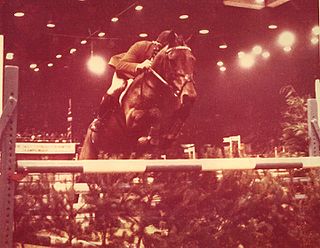 W
WThe Horse of the Year Show - also known as HOYS - was founded to be a culmination of the British equestrian events year. The Show was the idea of Captain Tony Collings and was realised by the then Chairman of BSJA, Mike Ansell. As it was to be the end of Season Finale the show needed to be held indoors, making it a unique event.
 W
WA horse show is a judged exhibition of horses and ponies. Many different horse breeds and equestrian disciplines hold competitions worldwide, from local to the international levels. Most horse shows run from one to three days, sometimes longer for major, all-breed events or national and international championships in a given discipline or breed. Most shows consist of a series of different performances, called classes, wherein a group of horses with similar training or characteristics compete against one another for awards and, often, prize money.
 W
WLeadline is a horse show class for very young children, generally under the age of 7 years. An adult or older child actually leads the horse in-hand, while the child that is judged sits on the horse and usually holds the reins, but only for the sake of appearance, as the actual control of the animal rests with the handler on the ground. Rules vary tremendously from one geographical region to the next, but as a rule the horse is shown at a walk and a trot, and the riding child is judged on their equitation, limited to proper seat, leg and hand position, to a lesser extent on poise. The child is usually not asked to actually control the animal, though in some locations a judge may award extra points if the child initiates certain commands to the horse and even more points if the horse actually responds. In many areas, judge may also ask the children simple questions about themselves or their horse, primarily to gauge the child's poise and manners more than equine knowledge. Occasionally, other elements, such as games or other group exercises may be added.
 W
WThe National Reined Cow Horse Association (NRCHA) is an equestrian organization in Pilot Point, Texas, United States, that began by promoting and staging Working cow horse events.
 W
WThis List of National Reined Cow Horse Association Hall of Fame Inductees was created by the National Reined Cow Horse Association (NRCHA) for the NRCHA Hall of Fame to recognize extraordinary athletes, individuals, riders, and horses in the equestrian sport of Working cow horse. The organization is headquartered in Pilot Point, Texas.
 W
WThe National Reined Cow Horse Association Champions and Awards are presented by the National Reined Cow Horse Association to outstanding individuals in the sport of Working cow horse, both people and equine. The NRCHA awards world champions on a yearly basis. It also awards million dollar earners for both riders and sires. The organization is headquartered in Pilot Point, Texas.
 W
WThe National Snaffle Bit Association (NSBA) is an equestrian organization in the United States that began by promoting and staging Western Pleasure events in 1983. Since then, focus has expanded to promoting the show horse at every level across multiple disciplines. The association is currently headquartered in Gurnee, Illinois, United States. The NSBA has a partnership with seven alliance breed organizations, including the American Quarter Horse Association (AQHA), American Paint Horse Association (APHA), American Buckskin Registry Association (ABRA), Appaloosa Horse Club (ApHC), International Buckskin Horse Association (IBHA) Palomino Horse Breeders of America (PHBA) and Pony of the Americas Club, Inc. (POAC) in order that associations can benefit from the many rules and regulations they have in common.
 W
WOlympia London International Horse Show is one of the UK's biggest equestrian competitions, held at Olympia, London. It is best known for its showjumping, however it also has competitions in horse showing, driving, mounted games, dog agility and more recently dressage. Evening sessions are broadcast live by the BBC each year, with the puissance. It is held over seven days in the week preceding Christmas that involves over 400 horses and ponies, and many of the events are Christmas themed.
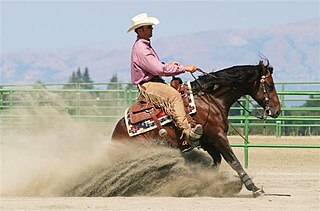 W
WReining is a western riding competition for horses where the riders guide the horses through a precise pattern of circles, spins, and stops. Reining is also considered to be a lot like figure skating. All work is done at the lope, or the gallop. Originating from working cattle, reining is often described as a Western form of dressage riding, as it requires the horse to be responsive and in tune with its rider, whose aids should not be easily seen, and judges the horse on its ability to perform a set pattern of movements. The horse should be willingly guided or controlled with little or no apparent resistance and dictated to completely. A horse that pins his ears, conveying a threat to his rider, refuses to go forward, runs sideways, bounces his rear, wrings his tail in irritation or displays an overall poor attitude is not being guided willingly, and is judged accordingly.
 W
WRollkur or hyperflexion of the horse's neck is an illegal practice in equestrianism defined as "flexion of the horse's neck achieved through aggressive force" and is banned by the world governing body, the International Federation for Equestrian Sports (FEI). The FEI recognises a distinction between rollkur and the riding of the horse in a deep outline not achieved by force.
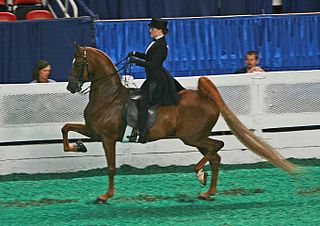 W
WSaddle seat is a style of horse riding within the category of English riding that is designed to show off the high action of certain horse breeds. The style developed into its modern form in the United States, and is also seen in Canada and South Africa. To a much lesser extent, it is ridden with American horse breeds in Europe and Australia. The breeds used for this flashy style are typically the showy Morgan Horse, and the high stepping American Saddlebred.
 W
WThe show hack is a type of ridden show horse, exhibited to a standard first established in England.
 W
WThe Hunter division is a branch of horse show competition that is judged on the horse's performance, soundness and when indicated, conformation, suitability or manners. A "show hunter" is a horse that competes in this division.
 W
WThe show hunter is a type of show horse commonly seen at equestrian events across Britain. The British "show hunter" is shown primarily on the flat, while the "working hunter" must also jump a series of rustic fences.
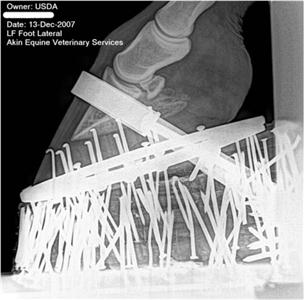 W
WSoring is the use of chemicals or mechanical devices to cause pain to the front feet and legs of horses when they touch the ground. This results in the horses picking up their front feet higher and faster than they would do naturally. It is illegal in the U.S. under the Horse Protection Act of 1970. It is closely associated with a unique high-stepping action of the front legs called "big lick" movement in show ring Tennessee Walking Horses. Under normal circumstances, "big lick" action is created by horseshoes that have added pads and weight, usually combined with additional weighted chains or rollers placed around the pasterns to create dramatic, high-stepping flashy action of the horse's front legs, desired in the horse show ring. Practitioners of soring do so because they believe that the pain associated with this practice exaggerates the "big lick" to a greater degree and gives them a competitive edge over other horses. Other breeds that have a history of soring including the Racking Horse and the Spotted Saddle Horse.
 W
WThe United States Equestrian Federation Pony Finals is an annual championship for pony hunters, jumpers, and equitation. The event takes place over six days and is typically held at the Kentucky Horse Park in Lexington, KY. More than 600 ponies compete at the championship every year.
 W
WWestern dressage is an equestrian sport that combines the principles of dressage riding and the use of western tack. Riders typically wear western attire, such as button-up shirts, cowboy boots and jeans. All horse breeds are permitted to compete in western dressage.
 W
WWestern pleasure is a western style competition at horse shows that evaluates horses on manners and suitability of the horse for a relaxed and slow but collected gait cadence, along with calm and responsive disposition. The horse is to appear to be a "pleasure" to ride, smooth-moving and very comfortable. Most light horse breeds in the United States and Canada may compete in western pleasure classes, either in open competition or at shows limited to a single breed. However, horse conformation and temperament play a role in this event, and hence animals of stock horse breeds that are calm, quiet, have collected, soft gaits and the strong muscling required to sustain slow, controlled movement are the most competitive.
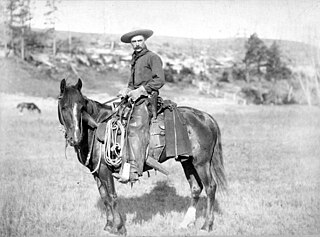 W
WWestern riding is considered a style of horse riding which has evolved from the ranching and welfare traditions which were brought to the Americans by the Spanish Conquistadors, as well as both equipment and riding style which evolved to meet the working needs of the cowboy in the American West. At the time, American cowboys had to work long hours in the saddle and often over rough terrain, sometimes having to rope a cattle using a lariat, also known as a lasso. Because of the necessity to control the horse with one hand and use a lariat with the other, western horses were trained to neck rein, that is, to change direction with light pressure of a rein against the horse's neck. Horses were also trained to exercise a certain degree of independence in using their natural instincts to follow the movements of a cow, thus a riding style developed that emphasized a deep, secure seat, and training methods encouraged a horse to be responsive on very light rein contact.
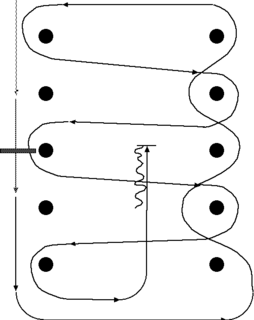 W
WWestern Riding is a competitive event at American horse shows, particularly those for stock horse breeds such as the American Quarter Horse. It is not to be confused with the general term "western riding," referring to the many forms of equestrianism where riders use a western saddle; instead, it refers to a particular class where the horse and rider complete a pattern that incorporates elements of both reining and trail classes, but requiring horses to perform in a quiet style akin to that of a Western pleasure class. Horses are evaluated on “quality of gaits, lead changes at the lope, response to the rider, manners and disposition." While all three gaits are required, most of the pattern is performed at a lope. Emphasis is placed on the horse's smoothness, even cadence, and precise, clean flying lead changes.